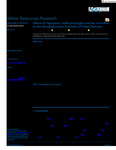Effects of Vegetation, Sediment Supply and Sea Level Rise on the Morphodynamic Evolution of Tidal Channels
| dc.contributor.author | Sgarabotto, Alessandro | |
| dc.contributor.author | D'Alpaos, A | |
| dc.contributor.author | Lanzoni, S | |
| dc.date.accessioned | 2021-08-09T10:07:41Z | |
| dc.date.available | 2021-08-09T10:07:41Z | |
| dc.date.issued | 2021-07 | |
| dc.identifier.issn | 0043-1397 | |
| dc.identifier.issn | 1944-7973 | |
| dc.identifier.other | ARTN e2020WR028577 | |
| dc.identifier.uri | http://hdl.handle.net/10026.1/17412 | |
| dc.description.abstract |
<jats:title>Abstract</jats:title><jats:p>Tidal channels play a leading role in the morphodynamic evolution of tidal environments by driving the exchange of water, sediments, and nutrients within these systems. Despite their fundamental function on landscape construction, current knowledge on their plano‐altimetric evolution in response to environmental forcing is still limited. We developed a mathematical model to address the interplay of biogeomorphic processes on the plano‐altimetric equilibrium of a straight tidal channel flanked by adjacent intertidal platforms. The model couples a one‐dimensional hydrodynamic model with a bed evolution model. The former describes the flow field within the channel and the storage contribution of lateral shoals. The latter accounts for the main physical processes responsible for shaping the tidal landscape, namely erosion, deposition, and sea level rise, mediated by halophytic vegetation growth. Model results reproduce a variety of channel morphologies, ranging from those typical of tidal‐flat channels, with large width‐to‐depth ratios, to those characterizing salt‐marsh creeks, which have much narrower cross sections and small width‐to‐depth ratios. Our results show that vegetation encroachment on the marsh surface produces two competing effects. First, vegetation increases flow concentration within the channel, owing to the increased flow resistance on the vegetated platform thus favoring channel incision. Second, vegetation promotes a reduction in the tidal prism, owing to higher accretion rates of the salt‐marsh surface thus leading to channel infilling. Which effect prevails over the other depends on the elevation of the intertidal platform in the tidal frame. The latter is in turn dictated by sediment availability, the rate of relative sea level rise, and vegetation biogeomorphic effects.</jats:p> | |
| dc.language | en | |
| dc.language.iso | en | |
| dc.publisher | American Geophysical Union (AGU) | |
| dc.subject | tidal channels | |
| dc.subject | long-term evolution | |
| dc.subject | equilibrium | |
| dc.subject | vegetation | |
| dc.subject | biomorphodynamics | |
| dc.title | Effects of Vegetation, Sediment Supply and Sea Level Rise on the Morphodynamic Evolution of Tidal Channels | |
| dc.type | journal-article | |
| dc.type | Journal Article | |
| plymouth.author-url | https://www.webofscience.com/api/gateway?GWVersion=2&SrcApp=PARTNER_APP&SrcAuth=LinksAMR&KeyUT=WOS:000680092200018&DestLinkType=FullRecord&DestApp=ALL_WOS&UsrCustomerID=11bb513d99f797142bcfeffcc58ea008 | |
| plymouth.issue | 7 | |
| plymouth.volume | 57 | |
| plymouth.publication-status | Published | |
| plymouth.journal | Water Resources Research | |
| dc.identifier.doi | 10.1029/2020wr028577 | |
| plymouth.organisational-group | /Plymouth | |
| plymouth.organisational-group | /Plymouth/Faculty of Science and Engineering | |
| plymouth.organisational-group | /Plymouth/Faculty of Science and Engineering/School of Geography, Earth and Environmental Sciences | |
| plymouth.organisational-group | /Plymouth/Users by role | |
| plymouth.organisational-group | /Plymouth/Users by role/Academics | |
| dcterms.dateAccepted | 2021-05-29 | |
| dc.rights.embargodate | 2021-8-12 | |
| dc.identifier.eissn | 1944-7973 | |
| dc.rights.embargoperiod | Not known | |
| rioxxterms.versionofrecord | 10.1029/2020wr028577 | |
| rioxxterms.licenseref.uri | http://www.rioxx.net/licenses/all-rights-reserved | |
| rioxxterms.licenseref.startdate | 2021-07 | |
| rioxxterms.type | Journal Article/Review |


